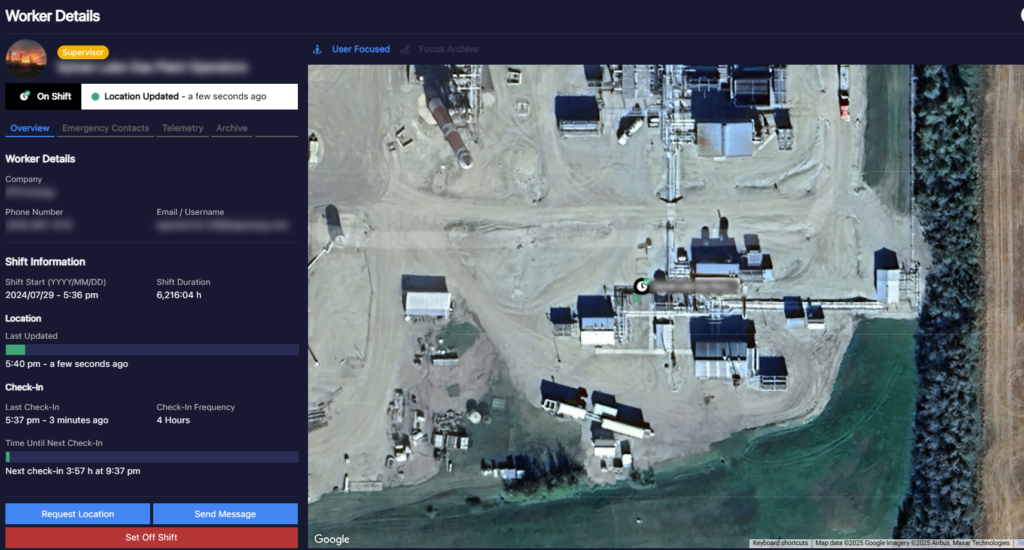Work Alone Safety Monitoring in Real-Time: Eliminating Check-In Gaps, Boosting Compliance, and Saving Lives
Introduction
Lone workers — employees operating without direct supervision — face hidden dangers daily. For decades, companies have relied on manual check-ins, radio calls, or SMS-based status updates to ensure their safety. These methods are flawed. Real-time lone worker safety monitoring offers a more reliable solution.

2. Traditional Work Alone Safety Tools and Procedures Are Failing Solo Workers
With advancements in technology, real-time work alone safety monitoring is becoming essential for ensuring the safety of solo workers.
“Legacy” work alone check-ins and monitoring…
- create monitoring gaps that delay emergency response.
- rely on human consistency, often under stressful conditions.
- may fail to meet evolving compliance requirements from agencies such as OSHA and CCOHS.
🧠 CCOHS, the Canadian Centre for Occupational Health and Safety advises, Employers should “Take corrective action to prevent or minimize the potential risks of working alone.”
✨ Enter: Real-Time Lone Worker Telemetry
Real-time telemetry solves the problem by streaming live data (location, status, movement, incident triggers) to a centralized platform, enabling immediate response and full situational awareness.
“The idea of safety coming first is kind of a ‘pipe dream’ for organizations which have not recently dealt with a serious incident. Real safety means eliminating gaps — not checking in every few hours. Compliance is a minimum – not a goal.”
— Colin Rees, COO, Be Safe
2. The Limitations of Scheduled Check-Ins
2.1 Safety Monitoring Blind Spots That Risk Lives
- Critical Response Timeframe: When an incident occurs between check-ins, critical emergency help may be delayed by 30+ minutes. In fact, a delay of more than 30 minutes has an increased chance of becoming a serious, preventable incident, or death.
- Human Error: Missed calls, miscommunication, and forgotten check-ins are all too common.
- Poor Scalability: Given that as your teams grows in due time, manual systems will fail to scale as a result. Especially for remote or high-risk roles, it’s important to realize that dangerous gaps in communication and manageability will eventually arise.
2.2 Real-World Failures in Work Alone Safety Monitoring
While speaking with a Canadian municipality, they recounted an incident where a member of their team, who was in their truck suffered a heart attack while parked roadside. The delay caused by scheduled check-ins resulted in tragedy — and a policy that banned working alone entirely, at great operational cost.
3. Real-Time Monitoring: What It Is and Why It Works
3.1 Key Features of a Real-Time Work Alone Safety Monitoring Safety System
- Live GPS tracking
- Automated fall detection
- Panic and accident/fall alerts
- Centralized data access
- Custom ERP-based escalation by group and individuals
See OSHA’s work alone guidance:
👉 OSHA 1915.84: Working Alone or in Isolation
3.2 Why Be Safe’s Work Alone Safety Monitoring Out-Performs Manual Check-Ins
- Faster Emergency Response
📉 NSC (National Safety Council) research shows up to 40% reduction in response time with continuous telemetry monitoring.
Source - Proactive Risk Mitigation
By continuously delivering live data, Be Safe enables real-time oversight. As a result, supervisors can effectively identify risks, take immediate action, and thereby prevent incidents before they escalate; ultimately improving safety outcomes. - Audit-Proof Compliance
Time-stamped digital logs help make passing safety audits seamless and demonstrate a higher degree of accountability; especially when responding to a safety incident.
4. Be Safe: A Real-Time Solution That Goes Beyond Check-Ins
4.1 Continuous Work Alone Safety Monitoring That Never Sleeps
- Live streaming of worker data
- Automatic triggers for automated alerts and manual call-outs
- Immediate alerts to internal safety teams and/or external responders

4.2 Custom ERP Integration
- Assign workers to ERP groups by location, role, or risk level
- Automate responses based on incident type
- Configure SMS, email, and human call-out chains by priority
4.3 Real Humans, Not Just Algorithms
Be Safe doesn’t rely on AI alone. Our Canadian-based live monitoring team escalates alerts personally and instantly — no delays, no third-party call centers.
4.4 Flexible, Cost-Conscious Pricing
- Usage-based billing: no contracts, no hidden fees
- Scales with your workforce
- Ideal for seasonal, rotating, or project-based teams
5. Quantifiable ROI: The Cost of NOT Having Real-Time Safety
Use the NSC Safety Technology Investment Calculator to estimate your savings.
Example: Oil & Gas Company with 50 Lone Workers
- Medical/Fine Reduction: $23,891
- Workers’ Comp Savings: $15,927
- Wage Loss Avoided: $3,981
- Absenteeism Reduced: $281,384
🎯 Total Annual Impact: ~$325,000 in avoidable costs
6. Regulatory Alignment: Stay Ahead of Compliance Risks
OSHA & CCOHS: Both Require Active Safety Monitoring
- OSHA 1915.84 calls for proactive steps for lone workers
- CCOHS Guidelines urge employers to move beyond passive systems
Telemetry Makes Compliance Easy
- Full logs of all worker status changes
- Escalation pathways for audit review
- Real-time tracking + history access
7. Bringing It All Together
Traditional check-ins are outdated.
Real-time telemetry is the future.
In conclusion, if your organization still regularly relies on scheduled calls or group messages, you’re ultimately leaving your people exposed to preventable risk, your liability will be left wide open.
💼 Ready to Protect Your Workforce?
✅ Schedule a Demo:
www.be-safe.ca
sales@be-safe.ca
1 (866) 510-2178
Be Compliant, Be Real-Time, Be Safe.
Check out our other news articles!
Be Safe – News

